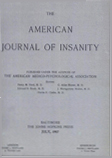THE FIRST YEAR OF THE NEW STANDARD NOMENCLATURE OF DISEASES IN MASSACTUETTS MENTAL HOSPITALS
Abstract
1. The American Psychiatric Association together with 21 other national organizations cooperated in writing the new "Standard Classified Nomenclature of Diseases" which was initiated in 1928. The first edition of the nomenclature (1933) carrying the new psychiatric classification, was revised and the final versions of the detailed and condensed classifications were officially adopted by the association in May, 1934.
2. Massachusetts mental hospitals and state schools adopted the new nomenclature in both mental diseases and mental deficiency as of June 1, 1934, and reclassified all admissions, discharges and deaths from that date back to the beginning of the statistical year, October 1, 1933. As the statistical system includes complete data on the resident population and patients out of institutions as well, all patients falling in these two groups were reclassified. A total of 36,711 diagnoses were reviewed by the medical staffs of the various hospitals. At the central department the new diagnoses were then transferred to statistical punch cards which are used in preparing annual statistics for all institutions and for the department annual report as well.
3. The figures for the number of cases falling in the 120 groups of the detailed classification are presented. These apply to all admissions (7222 cases), discharges (4837 cases), deaths 2001 cases) during the year 1934, and the resident population (23,196 cases) and patients out, etc., (2423 cases) at the end of the statistical year Sepember 30, 1934, by first and readmissions (Table 1).
4. The twelve main groups of the detailed classification are discussed from the viewpoint of numbers and percentages occurring among the admissions, discharges, deaths, resident population and patients out of institutions, for the year 1934. (Table 2). The numerical importance of the twelve main groups in the admissions is shown in the following table (percentages arranged in order of importance for first admissions):
See table in the PDF file
5. Certain of the main groups of the detailed classification tend to show high proportions in discharges, deaths or the resident population. The groups constituting more than 1.5 per cent of first admissions align themselves as follows:
See table in the PDF file
Access content
To read the fulltext, please use one of the options below to sign in or purchase access.- Personal login
- Institutional Login
- Sign in via OpenAthens
- Register for access
-
Please login/register if you wish to pair your device and check access availability.
Not a subscriber?
PsychiatryOnline subscription options offer access to the DSM-5 library, books, journals, CME, and patient resources. This all-in-one virtual library provides psychiatrists and mental health professionals with key resources for diagnosis, treatment, research, and professional development.
Need more help? PsychiatryOnline Customer Service may be reached by emailing [email protected] or by calling 800-368-5777 (in the U.S.) or 703-907-7322 (outside the U.S.).



